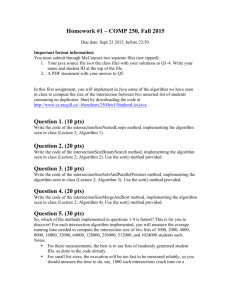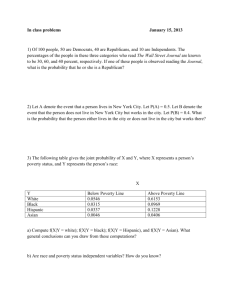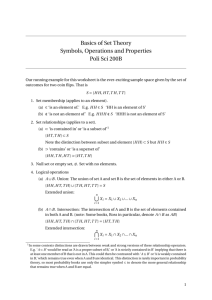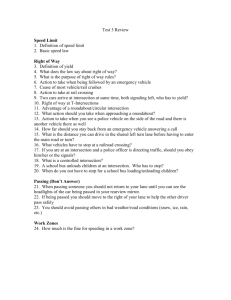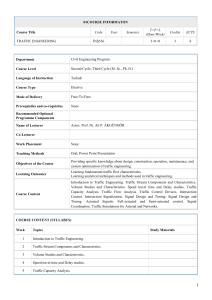Why Count? - Wisconsin Bike Fed
advertisement
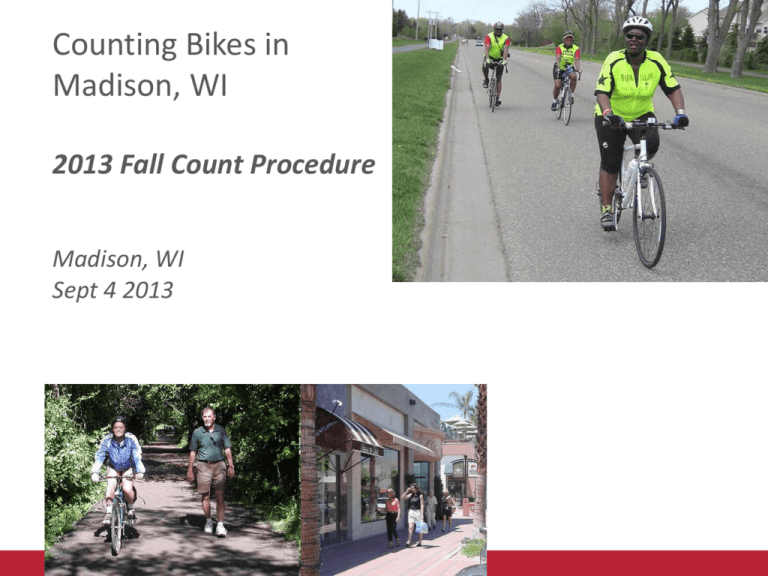
Counting Bikes in Madison, WI 2013 Fall Count Procedure Madison, WI Sept 4 2013 What is NBPD? • An on-going effort by private consultants with support from ITE • Annual national bicycle and pedestrian count and survey effort • Fulfills need for in-depth analysis of why people bike and walk • Objectives – Consistent data collection – Open access data – Shared research Need for NBPD • • • • Lack of consistent data Non-motorized modes lack funding Minimal national data sharing Analysis for other modes are based on marginal data yet receive substantive funding 3 NBPD Accomplishments • Over 75 organizations and agencies have sent data • Over 600 count locations • Extrapolation figures • Related projects: Caltrans Seamless Travel • Publicly available support documents including training presentations and count/survey forms • www.bikepeddocumenation.org 4 Why Count? • Evaluate need for new trails and trail upgrades • Evaluate community demand • Explain trail value to community, elected officials, grant agencies • Justify resource allocation • Forecast demand • Support grant applications Count Types • Screenline Count everyone who passes Intersection Count anyone who enters your intersection and note movement Screenline and Intersection Counts Screenline Counts Intersection Counts • Volume on a corridor • Volume • Simpler, allows counters to collect other info easily • Approximate exposure • Less training needed • More complicated • Automatic counters can be used • Requires more training • Turning movements • Automatic counters can’t be used Quality Control It is important to include quality control measures – Spot field checks – Review and verification of data within a day or two of collection to identify discrepancies – Use of counters who care a lot about bicycle and pedestrian issues has been shown to improve the accuracy of counts. Forms • Intersection form • Screenline form • Forms available on website Data Input Name Location Date Time Period Weather Intersection Count Form • Separate bicycle and pedestrian count forms • Does not differentiate by gender • Allows counters to collect turning movements • 15-minute intervals • 2-hour period can be collected on 1 sheet Data Input: Intersection Count Form 15 minute intervals Note movement through intersection May use different symbols for bikes/peds Or a symbol for sidewalk riding or road walking Data Input: Intersection Crossing Enter after field work Total and summarize data for after the count and for input into the national database Conducting Screenline Counts Screenline Count Count everyone who passes Count Form Data Input Name Time Period Location Weather Date Data Input By gender 15 minute intervals People on Bicycles Pedestrians - including wheelchairs Others - skateboarders & rollerbladers Anybody passing the screenline (from both directions) Data Input 4 9 6 12 Returning Count Forms • Count forms collected by the sponsoring agency • Enter data in spreadsheet available at: www.bikepeddocumentation.org – NBPD updated the spreadsheets for the 2009 count effort • Send data sheets to data@bikepeddocumentation.org Subjects How do you count this? How do you count this? 5! How do you count this? How do you count this? 2! How do you count this? How do you count this? 4! How do you count this? How do you count this? Other! By the park. How do you count this? How do you count this? 0! How do you count this? How do you count this? 2! How do you count this? How do you count this? 2 Day of Count • Be available to Abby via text, phone and social media • Bring a hat • Bring some water • Bring extra pens or pencils • Wear comfortable shoes • Be ready to count! Questions? Thank you! Ann Freiwald velocity1963@gmail.com www.bikepeddocumentation.org
